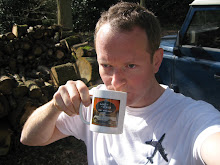Last August I begin hatching
Ixworth chicks from 4 different sources. The
Ixworth chicken is supposedly a 'Rare Breed'.
I think the breed is interesting for two reasons. It was the first serious attempt in the UK to develop a proper commercial breed that was both an excellent layer while retaining good eating qualities. Developed in the early 1930s by the now modestly famous Reginald Appleyard his efforts were somewhat over-shadowed by the war in Europe.
The second reason it's an interesting breed is because the plucky Brit failed. While he succeeded in creating an excellent table bird with good laying qualities this wasn't enough. The larger and more scientifically based poultry industries of the United States had made his product obselete. The American food industries had better genetics and the advent of large scale incubation meant hatcheries could churn out thousands of chicks per day and male chicks became disposable. It was now possible abandon dual purpose breeds . The industry bifurcated into specialist breeds for the table and for laying.
And this is where we are now. Hybrid layers will lay 325 eggs per year and a factory farmed supermarket chicken will go from hatching to chiller in less than 8 weeks. Mr Appleyard's Ixworth is good for neither which I guess puts it on the RBST (Rare Breed survival Trust) endangered list. (200 eggs per year and 4 months to table weight.)

Endangered is a bit of a stretch though. I've got a freezer full of them and had no trouble finding 4 different breeders. So back to last August. I hatched out 4 dozen eggs and reared them in the stables through 'till December. Having leg banded them and weighed them at intervals I could plot their growth rates and identify the lighter girls. After some weeks out in the snow and rain the boys were gathered up and have become curries, casseroles and chicken portions. The two prize cockerels were kept for breeding purposes. n The hens are to become my main layers of cream coloured eggs.
This should have left the girls happily mingling with their cousins (the Copper Marans) out in the field. However, on return from from our recent trip to India there was one cockle-doo-do-loo too many. It seems an undersized male had been masquerading as a lady hen and dodged the deep freeze. Chicken #5 is now on his way, God bless him.
 With the water lines back on and the ice gone I have stopped filling buckets from the kitchen each morning. The pigs now have their water trough in service I just had to show them where to find it and how to use it. I wonder if the electric fence is might be a bit too fierce because they've been rather shy about leaving the straw bedding in the stables. Throughout the last week I have fed them each morning (in the dark) a few meters further from the stables each day. This morning I found them in the depths of the woods, knee deep in mud, probably rooting around for frogs or something else delicious that you find in mud. Anyway, here are some pics I took with Sabine this afternoon.
With the water lines back on and the ice gone I have stopped filling buckets from the kitchen each morning. The pigs now have their water trough in service I just had to show them where to find it and how to use it. I wonder if the electric fence is might be a bit too fierce because they've been rather shy about leaving the straw bedding in the stables. Throughout the last week I have fed them each morning (in the dark) a few meters further from the stables each day. This morning I found them in the depths of the woods, knee deep in mud, probably rooting around for frogs or something else delicious that you find in mud. Anyway, here are some pics I took with Sabine this afternoon. Classic pig snouts, just like a child would draw. Nice muddy faces too.
Classic pig snouts, just like a child would draw. Nice muddy faces too.


